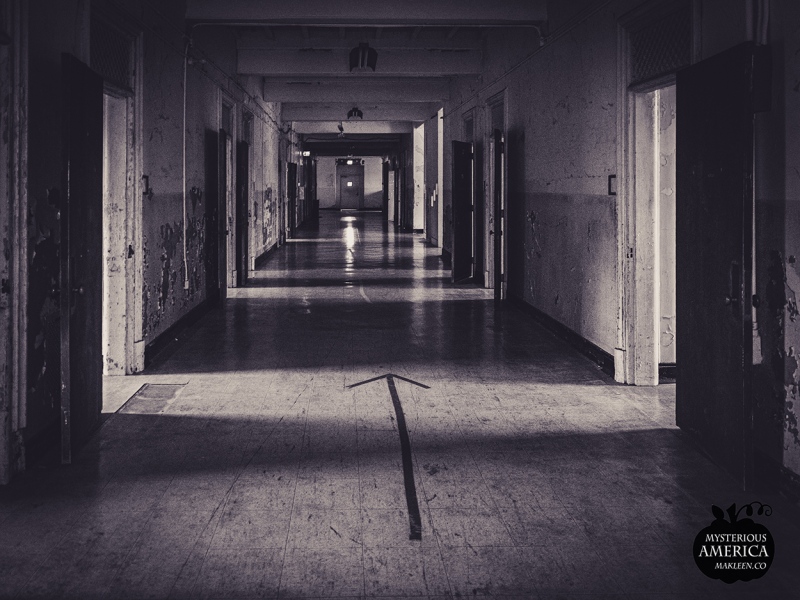A menagerie of tortured souls is said to lurk in these corridors.




Designed by Baltimore architect Richard Snowden Andrews in Gothic and Tudor Revival styles, construction on the Trans-Allegheny Lunatic Asylum began in 1858. Its main building was laid out according to the Kirkbride plan, brainchild of Superintendent of the Pennsylvania Hospital for the Insane Thomas Story Kirkbride. Kirkbride theorized that exposure to natural light and fresh air would aid in curing the mentally ill, so he designed a long, narrow hospital with staggered wings extending outward from the center. The furthest wings were reserved for the most violent or disturbed patients.
In 1861, the Civil War’s outbreak interrupted construction on Virginia’s new asylum as Union troops seized its construction funds from a local bank (totaling nearly $30,000.00 in gold) and used them to help fund a pro-Union Virginia government in Wheeling. When West Virginia seceded from Virginia in 1863 and was admitted to the Union, the new state government renamed it the West Virginia Hospital for the Insane. Construction on the sprawling grounds, with everything the hospital needed to be a self-sustaining community, wasn’t completed until 1881.
Originally designed to accommodate 250 patients in relatively comfortable surroundings with plenty of natural light and fresh air, conditions at the West Virginia Hospital for the Insane slowly deteriorated into a horror show. During the 1950s, its population peaked at a staggering 2,600 patients, with state and medical officials resorting to lobotomy to reduce overcrowding. Lobotomy was a procedure designed to make patients docile by severing connections in the frontal lobe of the brain. Though I couldn’t find any concrete numbers, it’s believed over a thousand lobotomies were performed there.
Like many large psychiatric hospitals, Weston State Hospital (as it came to be called) closed in the 1990s. It was added to the National Register of Historic Places in 1978 and the Weston Hospital Main Building was designated a National Historic Landmark in 1990. In 1999, local law enforcement officers used the abandoned hospital to play paintball, and it sat empty for years. Preservation efforts bore fruit in 2007 when Joe Jordan purchased the building for $1.5 million and opened it for tours.
An abandoned insane asylum, with sprawling wings and rooms bearing reminders of past patients, was a natural incubator for ghost stories, and paranormal-themed tours were baked into Jordan’s business model. Weston State Hospital has appeared in a cornucopia of TV shows, including Travel Channel’s Ghost Stories, Paranormal Challenge, and Ghost Adventures, Syfy’s Ghost Hunters, and Destination America’s Paranormal Lockdown, making it one of the most famous destinations for ghost hunting and dark tourism in America.
So what kind of paranormal activity allegedly occurs there? According to Trans-Allegheny Lunatic Asylum staff, phenomenon runs the gamut from apparition sightings to explainable voices and sounds. There are the ghosts of a girl named Lilly, men named Jesse and Jim James (or Big Jim), Ruth, and a nurse named Elizabeth, Civil War soldiers, and a murderer named “Slewfoot”. Visitors leave coins, cigars and cigarettes, toys, and even liquor (though not officially allowed) at various places around the asylum as offerings to the ghosts.
Marisa M. Kashino, writing in the Washingtonian, described a curious incident on her overnight ghost hunt. “Julia and I set up in a room allegedly haunted by a spirit named Jim James,” she wrote. “We placed a Maglite on the floor and asked Jim to turn it on. The light was Julia’s, but I inspected it and it seemed totally ordinary. A few beats passed—then it came on. By itself. I offered Jim a cigarette to turn it back off. It went dark.”
The most widely-known ghost to allegedly inhabit Trans-Allegheny Lunatic Asylum is that of an adolescent girl wearing a white dress named Lily. According to Thought Catalog’s Jerome London, it’s believed Lily was born at the asylum and grew up there, tragically dying at the age of nine. Her ghost plays in the children’s ward, laughing, rolling balls along the floor, and playing a music box.
During my tour of the asylum, our guide took us to the attic, which had been converted from visitor housing to patient rooms to ease overcrowding. At the end of a row of identical rooms, there was a room with a closet in which our guide invited three guests to sit for a few minutes. Anyone brave enough to sit in the dark closet experienced a strange sense of calm and noted a rapid passage of time, he explained. One after another, three women sat in the closet, and all three reported the phenomenon to one degree or another. Whether this was due to something paranormal, or the effects of being in a dark, confined space, is debatable.
Whether or not you believe the numerous reports of paranormal activity at Trans-Allegheny Lunatic Asylum, the opportunity to explore the history, architecture, and artifacts of the building is well worth the drive. When it was in operation, access to the public was severely restricted, but now you are free to roam its corridors for a small fee. Who knows what you might discover hiding in the shadows.
Trans-Allegheny Lunatic Asylum, at 71 Asylum Drive in Weston, West Virginia, closed for renovations earlier this year, but is currently open for tours until November 15th, Monday through Friday, 9:00am to 5:00pm. Historic tours leave every hour on the hour, paranormal tours leave every two hours, and the last 1st floor tour leaves at 5:00pm and the last 4th floor/paranormal tour leaves at 4:00pm. Call (304) 269-5070 for more information. Ample parking is available on site.

